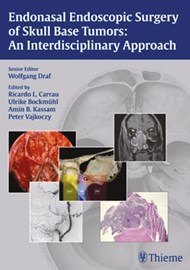This book sets itself apart from its peers by providing a unique interdisciplinary approach to skull base surgery. As the title implies, there is naturally a huge focus on endoscopic endonasal skull base surgery (between chapters 8 and 15). The earlier chapters touch on a myriad of topics, including the evolution of endonasal surgery, skull base anatomy, different skull base tumours, role of interventional radiology, interdisciplinary approach and the 360° philosophy.
Overall, the book is well-presented and rich with colour photographs and illustrations. Having trained in anterior skull base surgery, I found the 360° philosophy very interesting. The overview of different surgical approaches in not something most endonasal surgeons have had exposure to. A surgical atlas this is not. However, the presentation of tumour-specific strategies and surgical outcomes from two of the leading international skull base centres - Fulda, Germany (formerly headed by Professor Draf), and one joint programme at the University of Brescia and University of Varese, Italy - is absolute gold dust. For those in the nascent stage of their career, the judgement in managing skull base tumours, particularly when they are rare, can be incredibly challenging. These two high-volume centres have assiduously distilled what they have learnt over the years in this book for our benefit.
There are some chapters which are perhaps too detailed, like skull base anatomy. For surgeons, it would be useful to have surgical and radiological correlation of the osseous anatomy. These are relatively minor points. This book is ambitious in providing up-to-date insight into an evolving field of skull base surgery and the authors should be commended for delivering the brief so eloquently. I would highly recommend this book.




